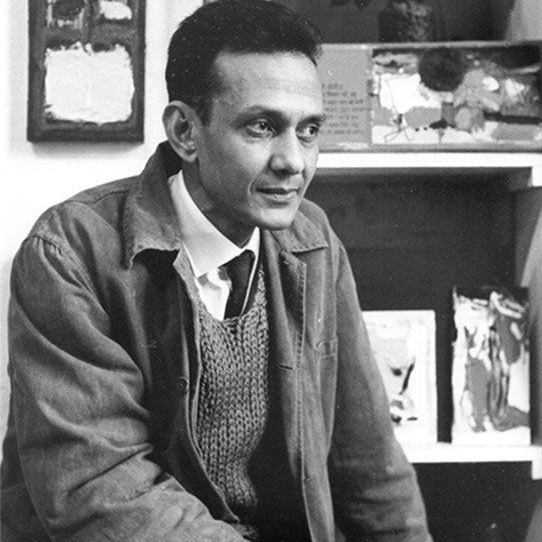
S. H. Raza
S. H. Raza stands as one of India's most revered and celebrated artists. Renowned for his mastery of abstraction and skillful use of colors, Raza's artworks exude a profound connection with Indian cosmology, encapsulating its essence and values.
Biography of the S. H. Raza
Syed Haider Raza was born in 1922 in Babaria, Mandla district, Madhya Pradesh. Raza discovered his passion for drawing at the age of 12 while residing in Babaria. When he was 13 years old, he moved to Damoh, also in Madhya Pradesh, where he completed his education at the Government High School.
After high school, Raza pursued further studies in art. He attended the Nagpur School of Art in Nagpur from 1939 to 1943 and the prestigious Sir J. J. School of Art in Mumbai from 1943 to 1947. In October 1950, he received a scholarship from the Government of France and moved to Paris to study at the École nationale supérieure des Beaux-Arts (ENSB-A) until 1953. After completing his studies, Raza traveled extensively across Europe and settled in Paris, where he continued to live and exhibit his artwork.
He had his first solo exhibition in 1946 at the Bombay Art Society Salon, where he was honored with the Silver Medal.
1947 was a crucial year for Raza, as he experienced both personal loss and artistic growth. That year, he lost his mother and co-founded the revolutionary Bombay Progressive Artists' Group (PAG) along with K. H. Ara and F. N. Souza. The group aimed to break free from the influence of European realism in Indian art and bring the Indian inner vision (Antar gyan) to the forefront. The PAG had its first show in 1948 when Raza's father passed away in Mandla, and most of his family migrated to Pakistan due to the Partition of India.
In 1956, he achieved a significant milestone when he became the first non-French artist to be awarded the Prix de la Critique in Paris. In 2007, he was honored with the Padma Bhushan, and in 2013, he received the Padma Vibhushan. The Republic of France recognized his accomplishments by awarding him the Legion of Honour in 2015.
In 2016 Syed Haider Raza passed away, leaving behind a legacy of profound and dynamic art that continues to inspire generations.
S. H. Raza's Art Style
Raza's art evolved from landscapes to abstract expressions, with his watercolors depicting landscapes and townscapes in the early 1940s transitioning into a more expressive language of painting landscapes of the mind.
While in France, Raza continued to experiment with Western Modernism, shifting from Expressionist styles to greater abstraction and incorporating elements of Tantrism from Indian scriptures. While his contemporaries focused on figural subjects, Raza was drawn to landscapes in the 1940s and 1950s, inspired in part by his move to France. In 1959, Raza married French artist Janine Mongillat, and in 1962, he became a visiting lecturer at the University of California in Berkeley, USA. During this period, his art portrayed the bucolic countryside and architecture of rural France, as seen in his work "Eglise."
As the 1970s approached, Raza became discontented with his work and desired to find a new direction and authenticity, moving away from what he termed "plastic art." His travels to various Indian locations, such as the caves of Ajanta-Ellora, Benaras, Gujarat, and Rajasthan, allowed him to reconnect with his Indian roots and culture. This resulted in the emergence of the "Bindu" in his artwork in 1980, symbolizing his rebirth as a painter. The concept of the Bindu held deep significance for Raza. The artist expanded his thematic oeuvre in the subsequent decades, adding newer dimensions and incorporating themes around the Tribhuj (Triangle) to reinforce Indian concepts of space and time, and 'prakriti-purusha' (the female and male energy). This transformation marked his shift from expressionism to mastery in abstraction and profundity.
Departing from his expressionistic landscapes, Raza embraced geometric abstraction and the concept of the "Bindu." For him, the Bindu represented the core of creation and existence, a source that propelled him towards various forms, colors, energies, sounds, spaces, and time within his art.
In 2000, his work took another leap as he delved into the realm of Indian spirituality, expressing his ever-deepening insights and thoughts through works centered around the themes of Kundalini, Nagas, and the Mahabharata.
Years:
Born in 1922
Country:
India, Babaria, Mandla